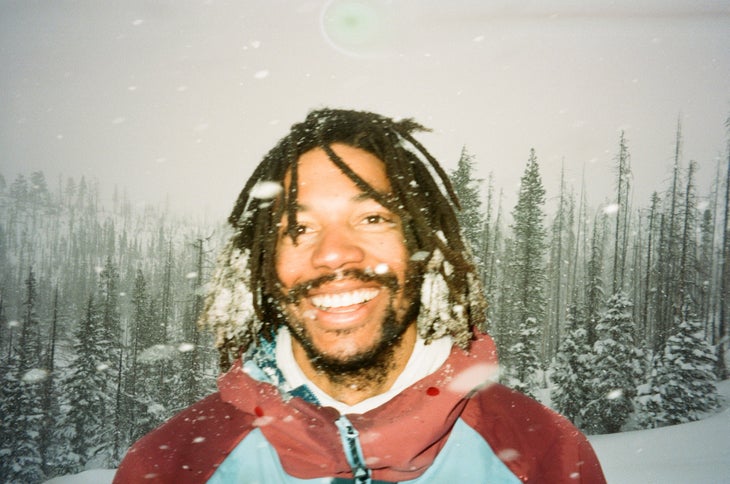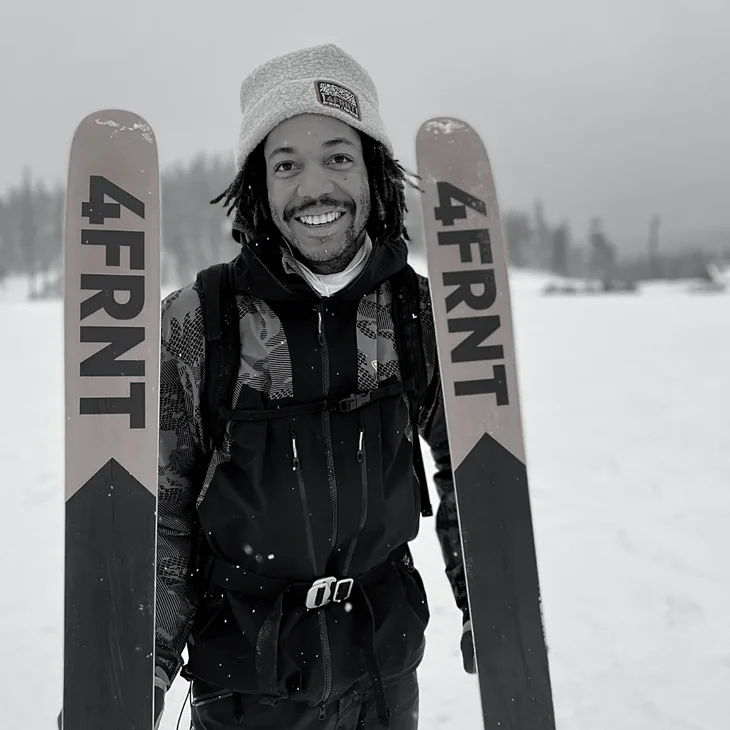Let’s be honest: There’s a tried-and-true formula that most ski movies follow. A group of heroes is on an all-too-familiar quest, then cue the slow-mo slashes, steep spines, and stylized shots … and repeat until the end. It can all blur into one long segment at times. And that isn’t necessarily a bad thing—we love a shreddy stoke film as much as the next person—but we can all agree that it gets repetitive at times.

, a Bend, Ore.–based skier and filmmaker, decided to throw out the rulebook with The Blackcountry Journal, a short film that mixes backcountry freeskiing with his lifelong passion for jazz. Beneath the smooth soundtrack and savory facade is a complex story about race in skiing, although the nuance may take a few views to rise to the surface. Shot in monochrome and structured in three parts, the film abstractly follows Duncan’s story as black man trying to find his place in the white ski industry.
We sat down with Duncan upon his return from the Banff screening to learn about the making of The Blackcountry Journal. Be sure to when it’s released to the public on Nov. 8.
SKI: Welcome home! How are you?
Mallory Duncan (MD): I’m doin’ alright. Life is chaos right now. I’m juggling a lot, getting ready for the digital launch. I’ve been handling all the post production, from festivals to distribution. It’s been a huge learning experience, but also exhausting. I just got back from screening it at Banff this weekend, along with a bunch of films from CK9 and Level 1, and that contrast certainly made the film stand out.
SKI: What are a few of the recent lessons?
MD: The biggest one is how to say no. I need some time at my house to regroup. I was gone for three weeks and have more travel coming up, so I’m grateful for time at home. It’s all a balance. Also, it feels uncomfortable to promote something this much. That’s not me. I know it’s important for the film’s success and I only get to release my first ski film once, but it feels weird to be posting about it everyday. But, I am proud of what we made and want people to watch it, so I’m just going for it.
Also Read:
SKI: What’s the theme of the film?
MD: I have been processing this a lot so I appreciate you asking. It’s about “artistic” expression. Skiing doesn’t need to be the gnarliest line or raddest thing. It doesn’t need to be big, unattainable tricks. Instead of pushing limits, it’s about expressing myself on a slope. Looking up and seeing art. Developing my own style of skiing. I wanted to make the skiing relatable and focus on the creative aspects of filmmaking. Below that is a story about finding my place in the ski industry as a black man, but I didn’t want the race part to be heavy handed. You’ll either pick it up or you won’t, and either is okay with me.
SKI: The film is based around a couple poems you wrote; what are the most important lines?
MD: The first poem I wrote in late 2020 and it was the catalyst for the film. The second poem, the one that the film ends with, has been more impactful recently. One of my favorites I thought of while skiing Mount Jefferson. “Did you feel the rhythm of the wilderness, while you rested on a rocky shoulder, the beat of rock fall reverberating off the canyon walls.” It was a beautiful moment and it needed to be in the film.
Another is about appreciating the art left on the slope. “When you look back, didn’t you see the piece you played, improvised on the peaks’ paper flanks.” I love the alliteration of it. Making the film based on the poems helped me connect to skiing in a new way. I hope that it inspires others to express themselves too.

SKI: What other films did you use as inspiration?
MD: One in the ski world and one is not. The first is . It’s an experience just watching it. You can feel that energy without any words. I wanted to do that with The Blackcountry Journal. The second is by Topaz Jones. He’s a hip-hop artist and calling it a visual album doesn’t do it justice. It’s powerful because it can be interpreted in so many different ways. It’s a form of black art, by a black filmmaker, about black identity without putting it right in your face. I appreciate the subtly.
SKI: How does race play into your film?
MD: I wanted to show that black people have a place in skiing, not tell people how they do. I like to be about things, not talk about them. I live a black experience, but that doesn’t define me as a skier. While I will never deny my blackness, I don’t have to force it into conversations either. Just by existing in these spaces I am part of the movement for more representation in snow sports. It’s better to show, not tell.
SKI: Is there anything would you have done differently?
MD: There’s a lot of small tweaks and edits that I could obsess over for the rest of time, but generally speaking I’m really stoked on where it landed. Honestly. Sometimes I wish we added some of the bigger lines we skied in Alaska, but our goal was about the expression of the sport, not proving I’m a good skier. The open, mellow glacier skiing is where you really get to improvise and I’m happy we stuck to that.
SKI: Are you inspired to do more filming after this is behind you?
MD: Absolutely. I want to continue telling stories about skiing in a unique way, drawing connections to urban culture, music, and hip hop culture. We’re throwing around a lot of ideas right now and I can’t speak directly to them yet, but as someone who grew up in the city, I see an opportunity to make more ski films relatable to urban folks. I want to talk about skiing in a way that brings more people into the sport.
Watch The Blackcountry Journal on YouTube


